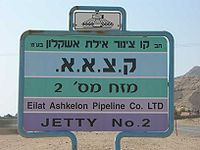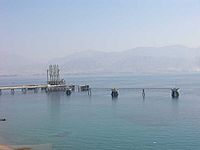
Eilat Ashkelon Pipeline Company
Encyclopedia
The Eilat Ashkelon Pipeline Company (EAPC) operates several petroleum and petroleum products pipelines
in Israel
, most notably the Eilat Ashkelon Pipeline
. It also operates two oil terminal and depots in the country. The company was originally formed in 1968 as a 50/50% joint venture between Israel and Iran
(during the Shah
's rule) to transport crude oil from Iran to Europe. When relations between Israel and Iran were severed after the Iranian Revolution
, Iran stopped taking an active part in the venture.
The services of EAPC are: transporting crude oil and refined products, long term storage, crude oil blending, processing of liquefied petroleum gas, fuel oil, destillates and gas.



to Southern Asia and the Far East
at a competitive price. The capacity and size of the Suez Canal
is limited and therefore expensive.
Pipeline transport
Pipeline transport is the transportation of goods through a pipe. Most commonly, liquids and gases are sent, but pneumatic tubes that transport solid capsules using compressed air are also used....
in Israel
Israel
The State of Israel is a parliamentary republic located in the Middle East, along the eastern shore of the Mediterranean Sea...
, most notably the Eilat Ashkelon Pipeline
Trans-Israel pipeline
The Trans-Israel pipeline , also known as the Tipline or the Eilat-Ashkelon Pipeline was built in 1968 to transport crude oil from Iran to Europe. The Iranians stopped the use of the pipeline after Shah Mohammad Reza Pahlavi was overthrown as a result of the Iranian Islamic Revolution of 1979...
. It also operates two oil terminal and depots in the country. The company was originally formed in 1968 as a 50/50% joint venture between Israel and Iran
Iran
Iran , officially the Islamic Republic of Iran , is a country in Southern and Western Asia. The name "Iran" has been in use natively since the Sassanian era and came into use internationally in 1935, before which the country was known to the Western world as Persia...
(during the Shah
Pahlavi dynasty
The Pahlavi dynasty consisted of two Iranian/Persian monarchs, father and son Reza Shah Pahlavi and Mohammad Reza Shah Pahlavi The Pahlavi dynasty consisted of two Iranian/Persian monarchs, father and son Reza Shah Pahlavi (reg. 1925–1941) and Mohammad Reza Shah Pahlavi The Pahlavi dynasty ...
's rule) to transport crude oil from Iran to Europe. When relations between Israel and Iran were severed after the Iranian Revolution
Iranian Revolution
The Iranian Revolution refers to events involving the overthrow of Iran's monarchy under Shah Mohammad Reza Pahlavi and its replacement with an Islamic republic under Ayatollah Ruhollah Khomeini, the leader of the...
, Iran stopped taking an active part in the venture.
The services of EAPC are: transporting crude oil and refined products, long term storage, crude oil blending, processing of liquefied petroleum gas, fuel oil, destillates and gas.
History



- 1956: "Afike Neft" (Crude Oil Channel) founded to transport crude oil from Sinai to Haifa
- 1957: construction of 3 oil tanks in Eilat, 20 cm (8") Ø pipeline from Eilat to Beer-Sheva, 3 oil tanks in Beer-Sheva, trains transport crude oil to Haifa, later construction of a 40 cm (16") Ø pipeline from Beer-Sheva to Ashdod and transportation by ship to Haifa
- 1959: construction of a 40 cm (16") Ø pipeline from Eilat to Haifa
- 1966: construction of the storage facility Ramat Yotam, Eilat, Jetty 1, booster station in Paran
- 1968: EAPC established, construction of a 106 cm (42") Ø pipeline from Eilat to Ashkelon, terminal and port in Ashkelon
- 1973: storage in Eilat expanded to 1.1 Mio. m3, in Ashkelon to 1.3 Mio. m3, additional booster station in Yotvata, 45 cm (18") Ø pipeline from Ashkelon to Ashdod
- 1996: construction of a sea and land terminal for fuel oil in Ashkelon
- 1998: construction of a modern LPG terminal
- 1999: joint venture EAPC and PEI, distallates unloaded in Ashkelon und distributed/pumped by PEI (Petroleum and Energy Infrastructures Ltd.)
- 2000: marine services moved to IEC (Israel Electric Company), coal jetty for Rutenberg Power Station
- 2002: conversion of storage tanks for destillates, filling station for tanker lorries
- 2003: reverse flow project finished (Russian oil delivered by tankers to Ashkelon, reloaded onto tankers in Eilat for shipment to Asia)
- 2004: modern filling plant for LPG cylinders
Crude oil pipelines
- Eilat portPort of EilatThe Port of Eilat is the only Israeli port on the Red Sea, located at the northern tip of the Gulf of Aqaba.-History:The Port of Eilat opened in 1957 and is today mainly used for trading with Far East countries. It allows Israeli shipping to reach the Indian Ocean without having to sail through the...
- Ashkelon portAshkelonAshkelon is a coastal city in the South District of Israel on the Mediterranean coast, south of Tel Aviv, and north of the border with the Gaza Strip. The ancient seaport of Ashkelon dates back to the Neolithic Age...
, 254 km, Ø 106 cm (42"), max 60 Mio. tons per year, 3 booster stations (YotvataYotvata-External links:*...
, Paran, Mashabei Sadeh) - Ashkelon port - Haifa RefineryOil Refineries LtdOil Refineries Ltd. , located in Haifa Bay, is Israel's largest Oil refinery. Using its state-of-the-art industrial facilities, ORL is capable of refining approximately 9.8 million tons of crude oil per year providing a variety of products used in industrial operation, transportation, private...
at Haifa portPort of HaifaThe Port of Haifa is the largest of Israel's three major international seaports, which include the Port of Ashdod, and the Port of Eilat. It has a natural deep water harbor which operates all year long, and serves both passenger and merchant ships. It is one of the largest ports in the eastern...
, 197 km, Ø 40 cm (16/18"), 3 pumping stations (Givati, Glilot, Hadera), max 5.5 Mio. tons per year - Ashkelon port - Ashdod RefineryAshdod Oil RefineriesAshdod Oil Refinery is second largest Oil Refinery in Israel, after Haifa Oil Refineries Ltd, located in coastal city of Ashdod. It was once part of governmental company Oil Refineries Ltd. After privatization of the company and solution to break the monopoly in Oil Refinery field, Ashdod oil...
, 36 km, Ø 40 cm (18/16"), max 7 Mio. tons per year
Products pipeline
- Eilat port - Giv'ati - Haifa refinery, 260 km, Ø 40 cm (16"), distillates (gasoline, jet fuel, gasoil)
The bidirectional reverse flow project
This project reversed the flow direction of Eilat-Ashkelon pipeline oil - meaning that it can now flow southwards instead of only northwards, as originally conceived when Israel consumed Iranian oil. The idea behind the project is to transport crude oil from Russia, central Asian republics and Caucasus over the Black Sea and the Baku-Tbilisi-Ceyhan pipelineBaku-Tbilisi-Ceyhan pipeline
The Baku–Tbilisi–Ceyhan pipeline is a long crude oil pipeline from the Azeri-Chirag-Guneshli oil field in the Caspian Sea to the Mediterranean Sea. It connects Baku, the capital of Azerbaijan; Tbilisi, the capital of Georgia; and Ceyhan, a port on the south-eastern Mediterranean coast of Turkey,...
to Southern Asia and the Far East
Far East
The Far East is an English term mostly describing East Asia and Southeast Asia, with South Asia sometimes also included for economic and cultural reasons.The term came into use in European geopolitical discourse in the 19th century,...
at a competitive price. The capacity and size of the Suez Canal
Suez Canal
The Suez Canal , also known by the nickname "The Highway to India", is an artificial sea-level waterway in Egypt, connecting the Mediterranean Sea and the Red Sea. Opened in November 1869 after 10 years of construction work, it allows water transportation between Europe and Asia without navigation...
is limited and therefore expensive.
- Ashkelon port - Eilat port, 254 km, Ø 106 cm (42"), max 20 Mio. tons per year, 2 booster stations
Oil ports
- Eilat, storage capacity 1.2 Mio. m3, for tankers up to , 16 storage tanks
- Ashkelon, storage capacity 1.5 Mio. m3, for tankers up to , 22 storage tanks

